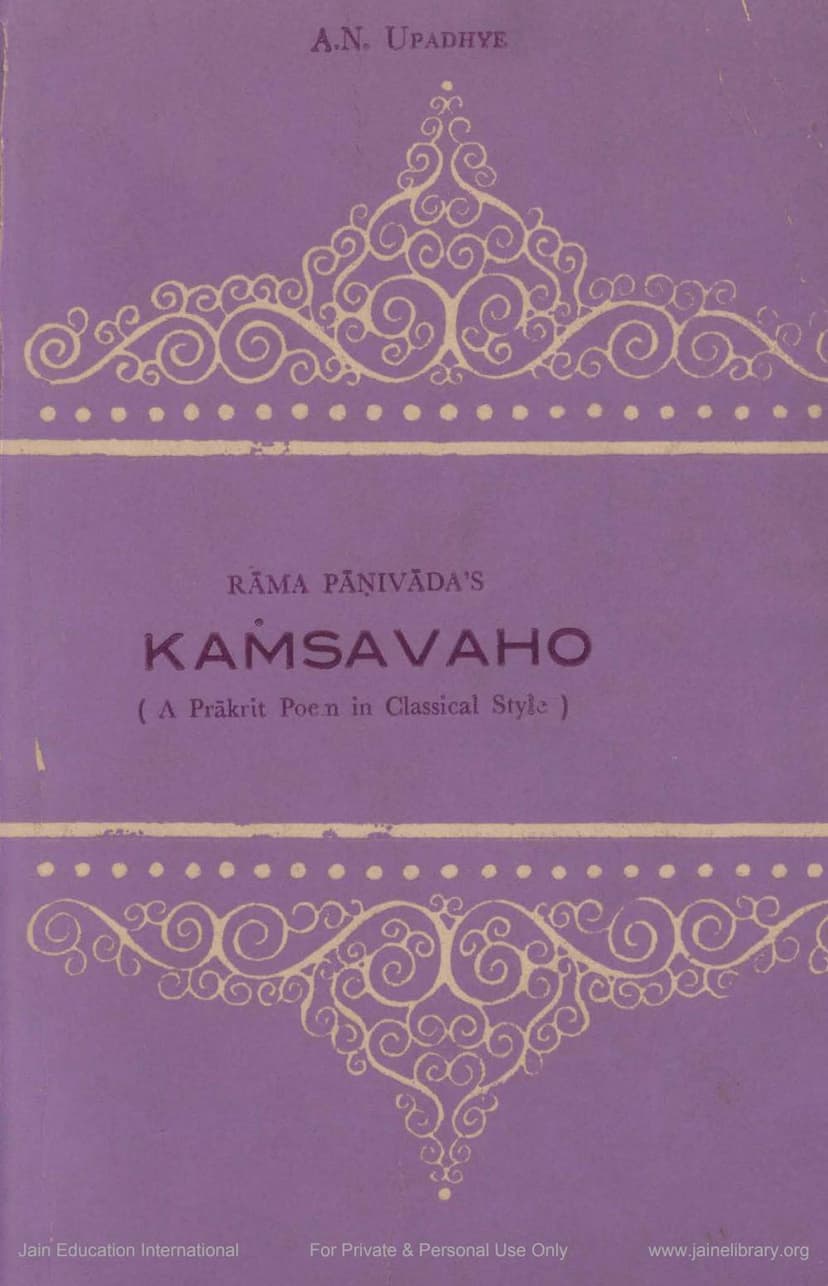Kansvaho
Added to library: September 2, 2025

Summary
The provided text is the critically edited edition of Rāma Pāṇivāda's Kamsavaho, a Prakrit poem in the classical style, brought out by Dr. A. N. Upadhye. The summary below is based on the Introduction and the content of the poem itself as described within the text.
Book Title: Rāma Pāṇivāda's Kamsavaho Author: Rāma Pāṇivāda Editor/Translator: Dr. A. N. Upadhye Publisher: Motilal Banarsidass
Overview:
Kamsavaho is a Prakrit poem composed by the 18th-century Keralan poet Rāma Pāṇivāda. The work celebrates the slaying of the tyrannical king Kamsa by Krishna. Dr. A. N. Upadhye's edition provides the Prakrit text, a Sanskrit translation (Chāyā), an English translation, and extensive critical and explanatory notes.
Rāma Pāṇivāda:
The introduction extensively details the life and works of Rāma Pāṇivāda, who was born around 1707 AD in Kerala. He belonged to the Pāṇivāda or Nambiar community, traditionally involved in Sanskrit theatre performances. Pāṇivāda was a prolific writer in Sanskrit, Malayalam, and Prakrit. His Sanskrit works include dramas and epic poems, demonstrating a deep influence from classical Sanskrit authors like Kālidāsa and Māgha. His Malayalam works are also numerous, contributing significantly to the regional literature. His engagement with Prakrit literature, including this poem, a commentary on Vararuci's Prākṛta-prakāśa, and another work Uṣāniruddham, showcases his mastery and broad literary engagement. He is believed to have died around 1775 AD.
Kamsavaho: A Critical Study:
- Theme and Title: The poem narrates the story of Krishna's victory over Kamsa, a narrative richly detailed in the Bhagavata Purāṇa. While the title focuses on Kamsa's slaying, the poem encompasses a broader biography of Krishna leading up to this climactic event. The title format follows earlier influential Prakrit poems like Rāvaṇavaho and Gauḍavaho.
- Source and Model: The primary source for the poem's content is the Bhāgavata Purāṇa. In terms of style and poetic structure, the poem shows a strong influence from Māgha's Sanskrit epic Śiśupālavadha, with numerous parallels in situations, ideas, and phrasing, without being a mere imitation.
- Summary of Contents:
- Canto One: Introduces Krishna in Gokula, his life among the Gopis, and the arrival of Akrūra sent by Kamsa to invite Krishna and Balarama to Mathura for a bow festival, which is a pretext for Kamsa to kill them. The canto also depicts the Gopis' sorrow at Krishna's departure and Akrūra's vision of Krishna's divine form.
- Canto Two: Narrates Krishna and Balarama's journey to Mathura. They encounter a washerman, whom Krishna kills, and then a humpbacked woman whom Krishna heals and enchants. They reach the gymnasium, where Krishna breaks Kamsa's formidable bow, impressing everyone. The canto concludes with Krishna and Balarama's entrance into the city of Mathura, with Krishna's poetic description of the city's grandeur.
- Canto Three: Begins with the bards announcing the dawn and praising Krishna. It details Krishna and Balarama's entry into the wrestling arena. They defeat the elephant Kuvalayāpīḍa and then engage in fierce duels with Kamsa's wrestlers, Cāṇūra and Muṣṭika, whom they defeat and kill. Finally, Krishna confronts and kills Kamsa himself, liberating his parents and restoring his grandfather Ugrasena to the throne. The canto also includes descriptions of celestial rejoicings.
- Canto Four: Primarily functions as an appendix, narrated by Akrūra to Krishna's parents. It recounts key episodes from Krishna's childhood and early life, including his divine exploits like lifting Govardhana Hill, his divine sports (Rāsa dance), and the defeat of various demons like Pralamba, Keśin, Vyoma, and Sankhacūda, all culminating in Kamsa's death. The canto concludes with a final verse by the author, encouraging the study of the poem and invoking Vishnu's protection.
- Prakrit Dialect: Dr. Upadhye analyzes the Prakrit dialect used by Pāṇivāda, noting that it primarily follows the grammatical rules of Vararuci's Prākṛta-prakāśa, particularly the first nine chapters. It shows influences from the Prakrit prose of dramas (Sauraseni characteristics) and also incorporates Sanskrit forms directly corrupted into Prakrit. The author also notes the deletion of initial consonants in some words and the retention of initial double consonants, likely due to conceiving expressions in Sanskrit first. He identifies the dialect as predominantly Mahārāṣṭrī, though with some Sauraseni traits, characteristic of the decadent period of Prakrit literature.
- Metres: The poem employs a variety of Sanskrit metres, with Vamsastha, Vasantamālikā, and Praharṣiņi being the most frequent. The Gāthā metre, typical of Prakrit poetry, is notably absent.
- Style: Pāṇivāda's style is influenced by classical Sanskrit literature, marked by a rich vocabulary and vigorous expression, though sometimes tending towards elaborate descriptions and lengthy compounds, especially in descriptive passages. While the language can become artificial at times, this is attributed more to the age and context of composition than to any deficiency in the poet's skill. The poet effectively uses verbal devices and wordplay, demonstrating a mastery of the language, and deserves a respectable place alongside other great Prakrit poets.
- Chāyā (Sanskrit Translation) and Authorship: Both manuscripts provide a Sanskrit rendering (Chāyā) which is largely identical. Dr. Upadhye tentatively suggests that Rāma Pāṇivāda himself might have authored the Chāyā to make the poem accessible to a wider audience.
Editorial Contribution:
Dr. A. N. Upadhye's edition is a significant contribution to Prakrit studies. His critical approach to the manuscripts, meticulous reconstruction of the text, and insightful analysis of the poem's literary, linguistic, and cultural aspects make this work invaluable for scholars of Indian literature and languages. The inclusion of the Sanskrit Chāyā and the English translation greatly facilitates the understanding and appreciation of this important Prakrit poem.